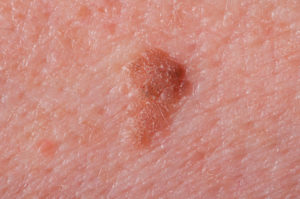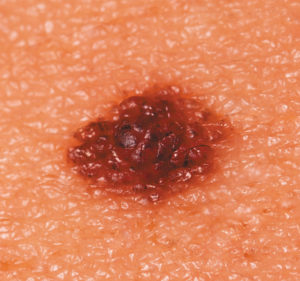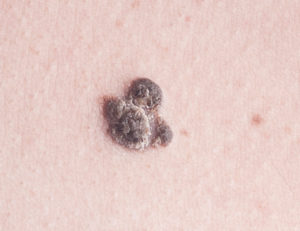Age Spots—Or Signs of Skin Cancer?
Skin cancer may seem less threatening than breast, lung, or colon cancers, but if you have the most serious form of skin cancer, melanoma, it can be fatal. A dermatologist can perform a thorough screening of your skin, but between appointments, you need to monitor your skin for signs of skin cancer. So how do you tell the difference between age spots, moles, and cancerous growths?
Identifying Skin Spots
If you’re 50 or older, you’re likely to notice new spots developing on your hands, face, and other areas of your skin that have received the most sun exposure. “Solar lentigines” is the medical term for these areas of skin discoloration that are commonly called “age spots” or “liver spots.”
“Lentigines are sharply defined patches that are tan or light brown in color. Benign (non-cancerous) moles are typically brown to darker brown, and they may be flat or raised. Melanomas may be larger and darker than moles,” explains Shari Lipner, MD, PhD, a dermatologist at Weill Cornell Medicine. (See What You Can Do for more guidance on identifying melanomas.)
Dr. Lipner says that lentigines may form due to a genetic disposition or as a result of sun exposure. Lentigines are not cancerous or dangerous, but people who have significant past sun exposure are more likely to have them, as well as an increased risk of developing skin cancer.
Eat Right, Starting Now!
Download this expert FREE guide, Complete Nutrition: Low-carb diet, high-protein foods, healthy meal plans, how to use a calorie counter, and more.
Create healthy meal plans and discover the Superfoods that can transform your plate into a passport to better health.
The Importance of Screening
If you’re at risk of skin cancer, it’s wise to have a full-body exam by a dermatologist every one to two years. A melanoma may not look very threatening, but the longer it goes undetected and untreated, the more likely the cancer will spread to other areas of your body.
“A board-certified dermatologist is best equipped to diagnose skin cancers. In addition to rigorous training, we also have special lighting and devices called dermatoscopes that help differentiate between lentigines, moles, and skin cancers,” says Dr. Lipner.
Between visits to your dermatologist, do a monthly self-check of your skin to monitor your moles, brown spots, and freckles, as well as any new spots or growths that appear. Perform your self-exam under a bright light, using a full-length mirror as well as a hand mirror. And, make sure to check your lips, mouth, ears, scalp, under your breasts, fingernails, and toenails, between your fingers and toes, the soles of your feet, and your genitals.
Know Your Risk
One million people age 65 and older develop some type of skin cancer each year, and they also have the highest death rate from melanoma. Cumulative exposure to the sun is the main contributor to older adults’ higher risk.
You’re also at higher risk of skin cancer if you have:
- Fair skin
- Red or blond hair
- A history of blistering sunburns and/or outdoor summer jobs for three or more years as a teenager
- A large number of moles
- A history of actinic keratoses (scaly pink or brown patches that are considered to be precursors to skin cancer)
- Marked freckling of the upper back
- A personal or family history of the disease
Protect Yourself
Reducing your exposure to the sun’s UV rays is the only action you can take to lower your risk of skin cancer.(See also “On the Lookout for Basal Cell Carcinoma Symptoms.”)
If you spend time in the sun, even in the winter, use a sunscreen with a sun protection factor (SPF) of 30 or higher that is labeled “broad-spectrum;” this means that it protects against both UVA and UVB light. Use sunscreen even on cloudy days—about 80 percent of the sun’s rays can filter through clouds.
Apply sunscreen 15 to 30 minutes prior to sun exposure. Cover any exposed skin, including your ears, lips, back of your neck, and your scalp if your hair is thinning. For added protection, stay out of direct sunlight between 10 a.m. and 4 p.m.
SKIN CANCER WARNING SIGNS
Follow the “ABCDE” rule as a guide when examining moles and other spots on your skin. Look for:
- Asymmetry, in which one half of the mole is shaped differently than the other half.
- Borders that are irregular, ragged, or blurred.
- Color that varies from one area to another, with shades of tan, brown, black, white, pink, red, or blue.
- Diameter larger than 6 millimeters (the size of a pencil eraser).
- Evolving, such as growing larger and/or changing color or shape.
The post Age Spots—Or Signs of Skin Cancer? appeared first on University Health News.
Read Original Article: Age Spots—Or Signs of Skin Cancer? »
Powered by WPeMatico





